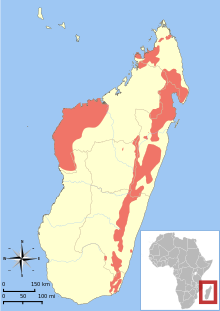Bamboo lemur
| Bamboo lemurs | |
|---|---|

| |
| Golden bamboo lemur (Hapalemur aureus) | |
| Scientific classification | |
| Domain: | Eukaryota |
| Kingdom: | Animalia |
| Phylum: | Chordata |
| Class: | Mammalia |
| Order: | Primates |
| Suborder: | Strepsirrhini |
| Family: | Lemuridae |
| Genus: | Hapalemur I. Geoffrey, 1851[1] |
| Type species | |
| Lemur griseus | |
| Species | |
|
Hapalemur griseus | |

| |
| Combined distribution of Hapalemur[3] | |
| Synonyms | |
| |
The bamboo or gentle lemurs are the lemurs in genus Hapalemur. These medium-sized primates live exclusively on Madagascar. The greater bamboo lemur, formerly known as Hapalemur simus, was considered part of this genus, but is now classified as belonging to the genus Prolemur.
Etymology
Bamboo lemurs were first described by French zoologist Isidore Geoffroy Saint-Hilaire in 1851. Comparing their small size, proportions, speckled fur, and other traits to those of marmosets—then classified in the genus Hapale—he named the genus Hapalemur. Hapale derives from the Greek word απαλός (hapalos), meaning "gentle".[4]
In their discussion of lemur name etymologies, Dunkel et al. speculated that the once popular vernacular name for the genus, "gentle lemur", derived from the translation of Hapalemur, despite their notoriety for being one of the most aggressive lemurs in captivity—an observation first noted in a letter by Dutch naturalist François Pollen published in 1895. More recently, the common name "bamboo lemur" (often used for both Hapalemur and Prolemur) first appeared in the mid- to late-1980s following the rediscovery of the greater bamboo lemur (Prolemur simus). However, the name became more generally used a year or two later following the discovery of the golden bamboo lemur (Hapalemur aureus) in 1987. For a few years, both names or combinations of both were widely used, but "bamboo lemur" became the preferred name in 1994 with the publication of the first edition of Lemurs of Madagascar. The term "gentle lemur" has seen little use in both popular and academic literature since the early 2000s.[4]
Description
This section needs additional citations for verification. (December 2014) |

The bamboo lemurs are characterized by a grey-brown fur, which varies by species. Their muzzles are short and their ears are round and hairy. Lengths vary from 26 to 46 cm, with tails just as long or longer, and they weigh up to 2.5 kg.
Bamboo lemurs prefer damp forests where bamboo grows. Although they can be active any time of the day, they are often active just after dawn. Though primarily arboreal, they sometimes come down to the ground. The Lac Alaotra gentle lemur or bandro (Hapalemur alaotrensis), which lives in the reed beds of Lac Alaotra, spends much of its time in water and can swim well, unlike other lemur species, which only venture to water to drink.
The lesser gentle lemurs live together in groups of three to five animals, which probably represent families composed of a male, one or two females, and their offspring. They communicate with a variety of sounds.
They are called bamboo lemurs because they almost exclusively eat bamboo. How bamboo lemurs can detoxify the high amounts of cyanide (from bamboo shoots) in their diets is unknown.[5]
Gestation lasts 135 to 150 days and ends between September and January, when the female bears one to two young. These are weaned after about four months (if the food supply is ample) and are fully mature at two years of age. Their life expectancy is up to 12 years.
Classification
As of 2010, the classification of bamboo lemurs lists five species and three subspecies.[6]
- Genus Hapalemur
- Eastern lesser bamboo lemur, H griseus
- Eastern lesser bamboo lemur, H. g. griseus
- Gilbert's bamboo lemur, H. g. gilberti
- Ranomafana bamboo lemur, H. g. ranomafanensis
- Southern lesser bamboo lemur, H. meridionalis
- Western lesser bamboo lemur, H. occidentalis
- Lac Alaotra bamboo lemur, H. alaotrensis
- Golden bamboo lemur, H. aureus
- Eastern lesser bamboo lemur, H griseus
References
- ^ Groves, C. P. (2005). Wilson, D. E.; Reeder, D. M. (eds.). Mammal Species of the World: A Taxonomic and Geographic Reference (3rd ed.). Baltimore: Johns Hopkins University Press. pp. 116–117. ISBN 0-801-88221-4. OCLC 62265494.
- ^ "Checklist of CITES Species". CITES. UNEP-WCMC. Retrieved 18 March 2015.
- ^ "IUCN 2014". IUCN Red List of Threatened Species. Version 2014.3. International Union for Conservation of Nature. 2012. Archived from the original on June 27, 2014. Retrieved 12 March 2015.
{{cite web}}: Unknown parameter|deadurl=ignored (|url-status=suggested) (help) - ^ a b Dunkel, A.R.; Zijlstra, J.S.; Groves, C.P. (2012). "Giant rabbits, marmosets, and British comedies: etymology of lemur names, part 1" (PDF). Lemur News. 16: 64–70. ISSN 1608-1439.
- ^ Ankel-Simons, Friderun (2007). Primate Anatomy an Introduction (3rd ed.). Academic Press. p. 53. ISBN 978-0-12-058670-7.
- ^ Mittermeier, R.A.; Louis, E.E.; Richardson, M.; Schwitzer, C.; et al. (2010). Lemurs of Madagascar. Illustrated by S.D. Nash (3rd ed.). Conservation International. pp. 315–316. ISBN 978-1-934151-23-5. OCLC 670545286.
